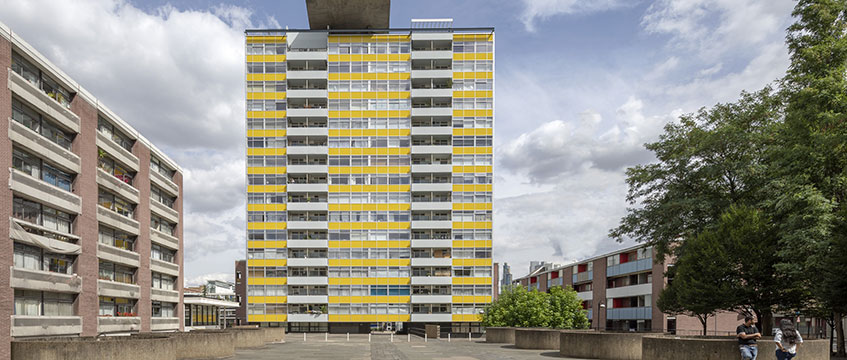Homeowners in Great Arthur House, a 120-residential block that is part of the Golden Lane Estate in the City of London, cannot be charged a total of £8m for repairs to the structure of the building, because the structural defects had been there since the building was constructed in 1957.
Judges at the Court of Appeal made the ruling yesterday (25 March), dismissing arguments from lawyers for the Corporation of London that they could pass on the cost to residents as a routine repair.
The 16-storey block was designed and built by celebrated architects Chamberlin, Powell and Bon, one of the UK’s most important modernist architectural firms.
The Golden Lane Estate, with its concrete and aluminium-framed cladding construction and raised walkways, was the firm’s first project and its first attempt to create a new blueprint for 20th century urban community living.
It led to the firm winning the commission to build the Barbican, its Le Corbusier-inspired masterpiece that towers over the adjacent and already-tall Golden Lane Estate.
Great Arthur House is a Grade II listed building. Like the Barbican, the Corporation of London is the freeholder, and many of the flats have been bought as 125-year leases under the right-to-buy legislation.
The building has suffered from water penetration for many years, and the Corporation has commissioned a number of expert reports. In particular, a report by structural engineering firm Jenkins & Potter found that the standard of construction of the framework, and in particular the formation of joints, was poor at a significant number of locations.
In addition, no allowance had been made for thermal movement, causing the aluminium frame to deform.
The Corporation undertook a major scheme of works to address these and other problems. It took place between 2016 and 2018, and cost £8m.
The Corporation wants to pass the entire bill on to the residents, at a cost of more than £172,000 per flat. The residents argue that they are not required to pay under the terms of their leases.
They argue that their leases, which require them to contribute to “specified repairs” do not make them liable to pay for defects inherent in the building from construction.
The Corporation argues that they can charge the residents because works do not cease to be works of repair merely because they simultaneously eradicate a defect in the building that has been there from the time it was constructed.
In yesterday’s ruling, a three-judge panel at the Court of Appeal backed the residents, and decided that the the cost of the works cannot be recovered from residents if they “make good a structural defect” that they were unaware of before taking on their leases.
Even so, Lord Justice Lewison, who wrote the judgment, said that the residents may still receive a bill, just not one for £8m.
“It is not as though the lessees have complete immunity,” he said. “They can be required to contribute to the cost of making good structural defects of which they were made aware before taking up the lease. They may also be made liable to contribute to the cost of making good structural defects of which the landlord only became aware 10 years or more after the grant of the lease. That achieves a fair balance between the interests of landlord and tenant.”
The mayor and commonalty and citizens of the City of London v Various leaseholders of Great Arthur House
Court of Appeal (Lewison J, Bean J, Arnold J), 25 March 2021
Timothy Straker QC and Jonathan Manning (instructed by the comptroller and City solicitor) appeared for the appellants; Christopher Baker (instructed by DAC Beachcroft) appeared for the respondents.











